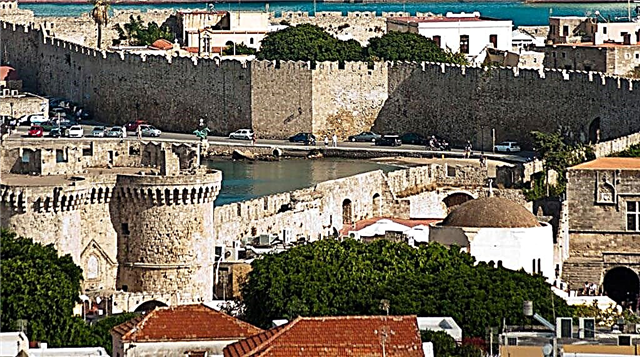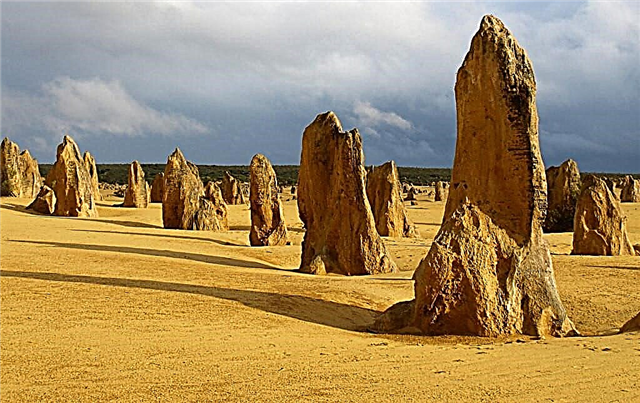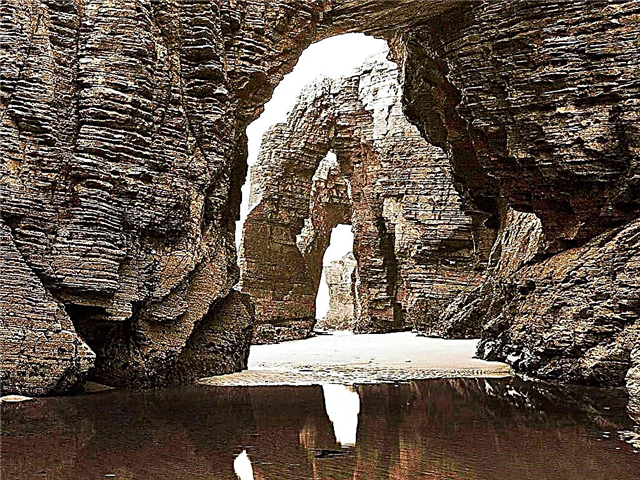In the north-east of Spain in Galicia, not far from the town of Ribadeo, on the shores of the Cantabrian Sea (as the Bay of Biscay is called in Spain) is Praia de Augas Santas or the Beach of the Holy Water. Tourists, however, call it a little differently: Cathedral Beach.

How the beach appeared
Despite such a loud name, there are no Christian churches here. All the buildings located here - stunning in beauty and grandeur - were created by a brilliant architect named Nature. As a sculptor, she cut off everything unnecessary from the mountain ranges in order to leave unique architectural masterpieces.
Under the influence of the salty water of the Atlantic Ocean and strong winds, soft rocks were washed out and weathered over time. As a result, the rocks took on such a shape that they really began to resemble Gothic cathedrals. They rise above the water like giant giants - to a height of more than 30 meters.

However, in all its splendor, this miracle of nature appears before travelers only at low tide. Then the water of amazing turquoise color (as in tropical lagoons) recedes, and before the amazed audience appear as "33 heroes" from the well-known Pushkin fairy tale, striking monuments and towers, giant arches, mysterious caves and labyrinths.
Actually, only at the time when the water moves away from the coast, this place can be called a beach, and only then you can walk along it. Travelers with great pleasure wander along the wet snow-white sand between the rocks, looking into the most secret corners, and take pictures to capture themselves against this amazing background. The rocks are so bizarre that each of them individually would make any beach in the world unique, and in this place - for some reason unknown to anyone - they are all gathered together in a not too large area.

The most beautiful places
The most interesting section of the Cathedral Beach stretches for a distance of about 300 meters. There will be enough time to get around it calmly and have a good look at everything, but it is not worth staying here for rest: the ebb tide will very soon be replaced by a tide, and so rapid that you will have to flee: you may not even have time to collect your things.
For those who are afraid to get their feet wet, it is recommended to view the beach from the bank of the cliff. A sightseeing path has been specially laid here, fenced off with a low parapet so that tourists do not accidentally fall down. Those who find themselves on the Beach of the Cathedrals at low tide (then only the peaks of the arches are visible from the water), or when there is strong sea waves (the same parapet protects from splashes - to be wet from head to toe is possible only when great desire).

Of course, it is better to walk along the coast - between the gigantic columns, but if you are not lucky, the view from above can be a consolation: it is as fantastic as it is from below. The cliffs are a favorite haven for seabirds. Ivory gulls against the backdrop of dark gloomy rocks are also a stunning sight that will not leave anyone indifferent.

One of the most photographed places in the world
At the end of the beach, one after another, there are 3 arches that cast doubt on their natural origin: so these structures of water and wind look like man-made. Just behind the arches are colonies of bivalve molluscs, also worthy of being featured in travelers' photo albums.
By the way, Praia de Augas Santas is very often chosen for filming by professional photographers: the views are such that everyone who saw their reports feels an irresistible desire to visit this extraordinary place. Cathedral Beach is one of the most photographed places in the world.

What to see
It is worth going through the beach from start to finish and be sure to look into all the caves and grottoes, even if you can't see the exit from them: the caves are small, so you won't get lost. But in any cave and any grotto, everyone will find something extraordinary and amazing for themselves. You can climb one of the not too high rocks (this is not forbidden here): from a higher point, the landscape will look somewhat different, which will allow you to look at it from a different angle and take slightly different pictures.

You do not have to go back to the stairs, on which you went down - if, of course, there is no car left in the parking lot. Moving forward all the time, you can go to another beach - Reinante. Behind the natural arches and columns, the terrain is not so impressive, but there will be an opportunity to observe the inhabitants of the sea, which are found in abundance here, and swim at the end of the path. By the way, the water in the Bay of Biscay is not very warm, but it is still worth taking swimwear with you. In addition, there are many tidal pools and grottoes on the beach of the Cathedrals, where the water is much warmer.

Travel Tips
One of the main tips: while in this place, you need to monitor the water level all the time in order to have time to return to the stairs or go to another beach until the water covers the whole land, otherwise you may find yourself in a difficult position (recall, the tide here very impetuous). However, the time of high tide will appeal to scuba divers - divers also have something to see here.
National natural monument
Cathedral Beach is a National Natural Monument. Experienced travelers have heard about it before, but now - with the development of telecommunications - it has gained worldwide fame. At the same time, absolutely everyone is amazed by the selectivity of nature: after all, having driven away from this place quite a bit, you will not find anything like it.
That is why thousands of tourists come here to admire the daily performance: every time the sea recedes, people feel like they are in the grandiose scenery created by nature itself, and are amazed at the harmony of incredible power and beauty. According to the results of international opinion polls, the Playa de las Catedrales beach is recognized as the most beautiful beach in Europe. This place is one of a kind and worth seeing.

When to go and how to get there
Do not forget that Galicia is the northwest of Spain, so the weather can be changeable even in summer. The best time to travel is July and August. It is also best to check the ebb and flow timetable in advance to see this place in all its glory.
Travelers are accepted by 3 airports in the cities of A Coruña, Vigo and Santiago de Compostela (the capital of Galicia), but there is no direct flight from Moscow to this region, so you will have to change trains either in Madrid or Barcelona. From Madrid to Santiago de Compostela (480 km) the journey takes approximately 1 hour 15 minutes, from Barcelona - 1 hour 30 minutes. Playa de las Catedrales can be reached by cars.
You can get to the beach from Ribadeo, there is a regular bus. Moreover, the schedule is made in such a way that the arrival time does not coincide with the tide. For the trip, adults will have to pay 2.5 euros, children - 1.5 euros. Directly in the Cathedral Beach area, there are approximately 25 hotels.
Arriving at their destination, tourists find themselves in the parking lot at the top of the cliff. Down - to the sea - a staircase leads. By the way, you can go down even during high tide - below there is a piece of land that does not flood with water (at least during normal high tide). But it should be borne in mind that this piece is quite small, it is located next to the stairs.

What else to see
Galicia primarily attracts people interested in culture and ecology. The capital of Galicia - Santiago de Compostela - is one of the most beautiful Spanish cities, which is a center of pilgrimage for Catholics from all over the world.In terms of attendance, it is not much inferior to the famous Barcelona: tourists from all over the world come to the walls of the Cathedral located here. In the city you can find historical monuments of various eras and cultures. The cities of Lugo, Pontevedra are also widely known due to the preservation of the historical zone.
Village and food tours are very popular in the region.











